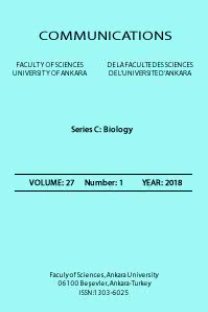Çubuk stream pollution and environmental effects
Çubuk stream pollution and environmental effects
The water quality parameters of Çubuk Stream were examined in terms of physical and chemical aspects and the pollution level of Çubuk Stream was determined by comparing these parameters with the Surface Water Quality Regulation (SWQR). For this purpose; samples were taken from three different stations between August 2012 and April 2013, the water samples were compared with each other and with previous studies, the water quality of Çubuk Stream was determined according to the surface water quality regulation. In our study, the biological oxygen requirement of Çubuk Stream according to SWQR (BOD5: 22.5mg/l) IV. class, ammonium nitrogen element (NH4–N:2.34 mg/l) IV. class, nitrite nitrogen element (NO2–N: 0.035 mg/l) II. class, nitrate nitrogen element (NO3 –N:0.95 mg/l) Class I, according to phosphate value (PO4:0.075 mg/l) Class I and trace elements (Pb, Cd, Cr, Ni, Mn) values Class I. water quality. According to the ratio of NH4-N/PO4 (2.34/0.075=31.2 mg/l), the element that limits eutrophication in Çubuk Stream is P. Compared to previous studies, after the wastewater treatment plants established in the region, higher quality water is provided, especially in terms of NO3 and PO4. It has been determined that the nitrogen and phosphorus ratios are high because the region, which is dense in terms of organic matter, is close to industrial establishments.
___
- Baysal, A., Genel Beslenme Bilgisi, Hatipoğlu Yayınevi, Ankara, 1989.
- Atalık, A., Küresel ısınmanın su kaynakları ve tarım üzerine etkileri, Bilim ve Ütopya, 139 (2006), 18–21.
- Özgüler, H., Su, su kaynakları ve çevresel konular, Meteoroloji Mühendisliği, TMMOB Meteoroloji Mühendisleri Odası Yayın Organı, 2 (1997), 57–63.
- Akın. B., Atıcı. T., Katırcıoğlu, H., Fersin, K., Investigation of water quality on Gökçekaya Dam Lake using multivariate statistical analysis in Eskişehir-Turkey, Environmental Earth Sciences, 63(6) (2011), 1251–1261. Doi: 10.1007/s12665-010-0798-6.
- Atıcı, T., Sakarya nehri kirliliği ve algler, Ekoloji Çevre Dergisi, 24 (1997), 28–32.
- Cirik, S., Cirik, Ş. Limnoloji, Ege Üniversitesi Su Ürünleri Fakültesi Yayınları, no: 21, İzmir, 1999.
- Egemen, Ö., Su Kalitesi, Ege Üniversitesi Su Ürünleri Fakültesi Yayını, İzmir, 2006.
- Taş, B., Çetin, M., Gökgöl (Ordu-Türkiye)’ün bazı fiziko-kimyasal özelliklerinin incelenmesi, Ordu Üniversitesi Bil. Tek. Dergisi, 1(1) (2011), 73–82.
- Harper, D. Eutrophication of Fresh Waters: Principles, Problems and Restoration, Chapman and Hall., London, 1992.
- Tepe, Y., Boyd, C.E., A reassesment of nitrogen fertilization for sunfish ponds. Journal of World Aquaculture Society, 34 (4) (2003), 505–511.
- Shah, C.R., Which physical, chemical and biological parameters of water determine its quality? (2017), Doi:10.13140/RG.2.2.29178.90569
- DSİ., 52. Yıl Çalışma Raporu, Ankara, 2006.
- http://www.webcitation.org/query?url=http%3A%2F%2Fwww.dsi.gov.tr%2F projeler%2Fcubuk-Çubukaj%25C4%25B1&date=2017-12-18.
- SWQR, Su Kirliliği Kontrolü Yönetmeliği. Numune Alma ve Analiz Metotları Tekniği, Resmi Gazete, sayı 20748 (7 Ocak), Ankara, 1991.
- SWQR, Su Kirliliği Kontrol Yönetmeliği, Resmi Gazete, sayı 29327 (15 Nisan), Ankara, 2015.
- Yıldız, H., Uzbilek, M., Çubuk çayında (Ankara) bentik makro omurgasızların yapısı, Tarım Bilimleri Dergisi, 7(3) (2001), 54–57.
- Atıcı, T., Ahıska, S., Ankara çayı kirliliği ve algleri, Gazi Üniv. Fen Bilimleri Enstitüsü Dergisi, 18(1) (2005), 51–59.
- Atakan, Y., Çernobil Kaynaklı Radyoaktif Serpintilerinin Çevreye ve İnsana Etkileri, TÜBİTAK Yayınları, Ankara, 1994.
- Ünlü, A., Çoban, F., Tunç, M.S., Hazar Gölü su kalitesinin fiziksel ve inorganik-kimyasal parametreler açısından incelenmesi, Gazi Üniversitesi Mühendislik Mimarlık Fakültesi Dergisi, 23(1) (2008), 119–127.
- Topbaş, T.M., Brohi, A.R., Karaman, M.R., Çevre Kirliliği, T.C. Çevre Bakanlığı Yayınları, Ankara, 1998. Sungur, D., Yıldız. K., Çubuk stream Bacillariophyta dışındaki algleri, G.Ü. Fen Bilimleri Enstitüsü Dergisi,11(2) (1998), 249–264.
- Shelknanloymilan, L., Atıcı, T., Obalı, O., Removal of nitrogen and phosphate by using Choleralla vulgaris on synthetic and organic materials waste water, Biological Diversity and Conservation, 5(2) (2012), 89–94.
- Ouyang, Y., Evaluation of river water quality monitoring stations by principal component analysis, Water Research, 39 (2005), 2621–2635.
- Gao, Y., Qian, H., Ren, W, Wang, Liu, F. Yang, F. Hydrogeochemical characterization and quality assessment of groundwater based on integrated-weight water quality index in a concentrated urban area, Journal of Cleaner Production, 260 (2020). Doi: 10.1016/j.jclepro.2020.121006.
- ISSN: 1303-6025
- Yayın Aralığı: Yılda 2 Sayı
- Başlangıç: 1943
- Yayıncı: Ankara Üniversitesi
Sayıdaki Diğer Makaleler
Histochemical effects of brodifacoum on rat spleen
Burcu BAYRAMLI ÖNER, Nursel GÜL
First records for benthic macroinvertebrate fauna in Güzeldere Waterfall, Turkey
Serap SEZER, Yaşar Murat ELÇİN
The effect of melatonin on rat soleus muscle treated with carbon tetrachloride
Duygu Fevziye VURAL, Hatice MUTLU EYİSON, Dilşad ÖZERKAN, Suna CEBESOY
Çubuk stream pollution and environmental effects
